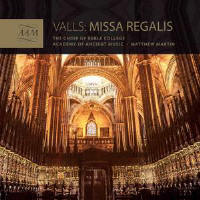Texte paru dans: / Appeared in: |
|
| ...this disc is a winner. |
Outil de traduction ~ (Très approximatif) |
|
Reviewer: James
V. Maiello
In recent years, a profusion
of recordings has brought the under-exposed music of early modern Spain to
ever-wider audiences. Timothy Roberts, for example, has embarked on a
complete cycle of the keyboard music of Joan Cabanilles for Toccata
Classics, and Cupertinos have released an exquisitely recorded reading of
Manuel Cardoso’s Requiem on Hyperion, just off the top of my head. Although
the situation is clearly being remedied, it remains something of a mystery
to me why Iberian music has received comparatively little attention than
other repertories of the same period. The composers are no less skilled, the
music no less well-crafted than comparable Italian or French music of the
period. With the present recording, one finds yet another reason why Spanish
Baroque music should occupy a more prominent place than it does. Francisco
Valls (1665?–1747) spent the bulk of his career in Barcelona, ultimately
rising to the position of Mestre di capella of the city’s cathedral. Here,
Matthew Martin and the choir of Keble College (Oxford) offer a highly
polished reading of the composer-theorist’s Missa Regalis interspersed with
keyboard tientos by Corrêa de Arouxo and Cabanilles. The Mass itself is a
fascinating mix of old and new, Renaissance counterpoint coexisting with
18th-century gestures and surprisingly modern rhythmic and harmonic
vitality. The Kyrie, which highlights Valls’s inventive counterpoint, is given a weightless, even gauzy reading by the choir. They spin out graceful lines without getting bogged down in the passagework, bringing dance rhythms subtly to the foreground. The choral sound is pure and refined. The Gloria is a little heavier, but never plodding. The singers are especially responsive to the text, adopting an exuberance that gets serious around “Qui tollis peccata mundi.” From a compositional perspective, the Credo an unexpected adventure, full of dissonances, including a recurring motive of four ninths to mark the mystery of the incarnation. Like the Gloria, there is an awful lot of text to sing in the Credo, and the diction in both of these movements is crystal clear. Valls uses conventional musical gestures to depict the text, often with an unexpected harmonic twist. The choir acts as facilitators here, guiding listeners confidently through the familiar and foreign. The Sanctus is short but not perfunctory. It is almost wild, packed densely with vivid harmonies and madrigal-esque shifts, all within a span of less than two minutes. This is offset by a decorous Agnus Dei to close the Mass. The choir has been prepared expertly and rehearsed thoroughly, and the singing is clean and cohesive throughout. The continuo playing was subdued and unobtrusive, but almost too much so. I was excited to see a bass violin and dulcian listed in the personnel, but I would have loved to hear more from these instruments. Matthew Martin also gives fine performances of three tientos (organ fantasias) that break up the movements of the mass. The organ in the Keble College chapel sounds great, and Martin’s tasteful registration choices and idiomatic interpretations make these welcome additions to the program. Since launching a few years ago, the AAM has established itself as a top-tier home for period instrument performan-ces, and this disc is no exception. The liner notes are also noteworthy, containing authoritative and erudite essays. In short, this disc is a winner.
| |
|
|
|
|
Cliquez l'un ou l'autre
bouton pour découvrir bien d'autres critiques de CD |
|




